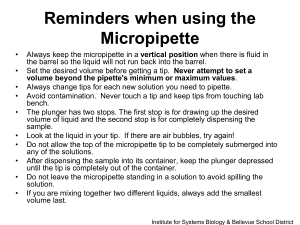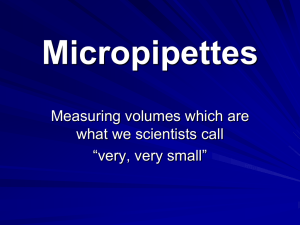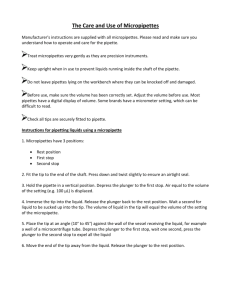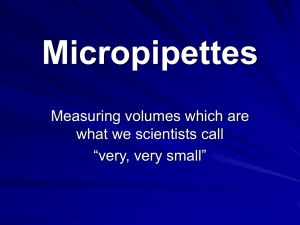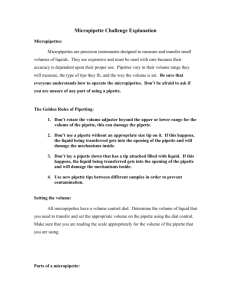precision
advertisement
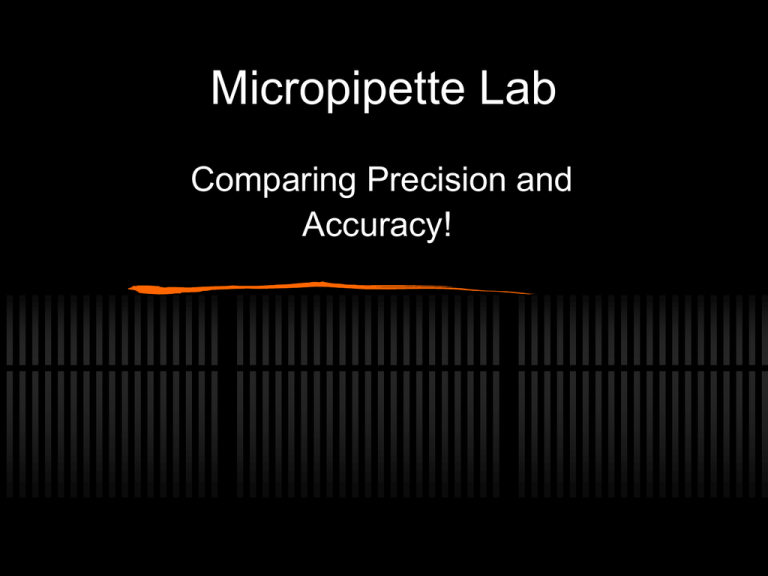
Micropipette Lab Comparing Precision and Accuracy! Cornell Notes & INB’s Q column: 1. Students write questions from notes 2. Everything in this column should be a question S - Set up the paper T - Take Notes A - After class process the notes 3 summary statements 1 questions R - Reflect / review Precision The precision of a measurement describes the “units” used to measure something The smaller the unit, the more precise! Example of Precision Ruler #1 can measure in centimeters QuickTime™ and a decompressor are needed to see this picture. “The pencil is a little over 9 cm” Ruler #2 can measure in millimeters QuickTime™ and a decompressor are needed to see this picture. “The pencil is a little over 95 millimeters Which ruler is more precise??? Ruler #2 Which tool can measure volume more precisely? QuickTime™ and a decompressor are needed to see this picture. 10 ml, 50 ml, or 100 ml graduated cylinder? How about compared to this tool? Quic kT ime™ and a dec ompres s or are needed to s ee this pi cture. 20µL = .020 ml Accuracy The difference between your measurement and the “accepted” value The bigger the difference, the less accurate you were! Examples of Accuracy Bob measured this container of milk And determined that it is 5.5 gallons Bob wasn’t very accurate! QuickTime™ and a decompressor are needed to see this picture. Maria measured this container of milk And determined that it is 1.1 gallon Maria was very accurate! Mai measured this container of milk And determined that it is 3.7854118 Liters = 3.7854118 liters Mai was accurate and precise! = 1 gallon These are accepted values Rules when using a micropipette Gently remove the disposable tip by depressing the button (not the top) Never use a micropipette without a tip Rules for using a micropipettor: o Gently remove the disposable tips with your fingers. o Never use the micropipetto r without a tip. This could cause damage to the instrument. o Never lay a loaded pipette down or til t it s ideways because this could allow liquid to run back into the instrument. o Never let the button snap back into place. Always allow it to rise slowly back into position. Never lay a loaded pipette down or tilt it sideways because this could allow liquid to run back into the instrument Never let the button snap back into place, always allow it to rise slowly back into position Let’s practice! Gently add a tip by pushing it onto the end of the pipette Slowly turn the top knob to set the desired measurement 200 is 200, 20 is 020 (large volume pipette) 20 is 200, 2 is 020 (small volume pipette) Slowly depress top knob down until you reach the “first stop” Slowly put tip of pipette into water and slowly release knob Depress top knob until you reach to “second stop” to release liquid Precisio n QuickTime™ and a decompressor are needed to see this picture.
